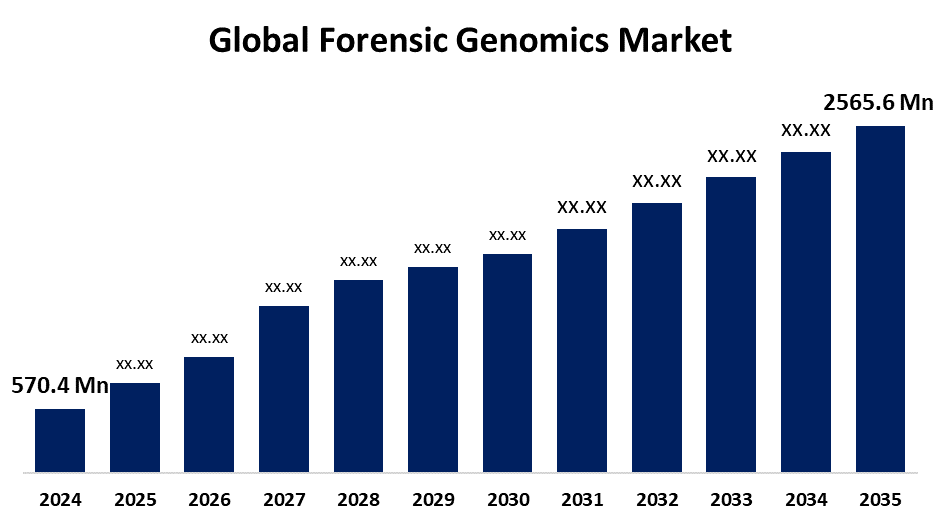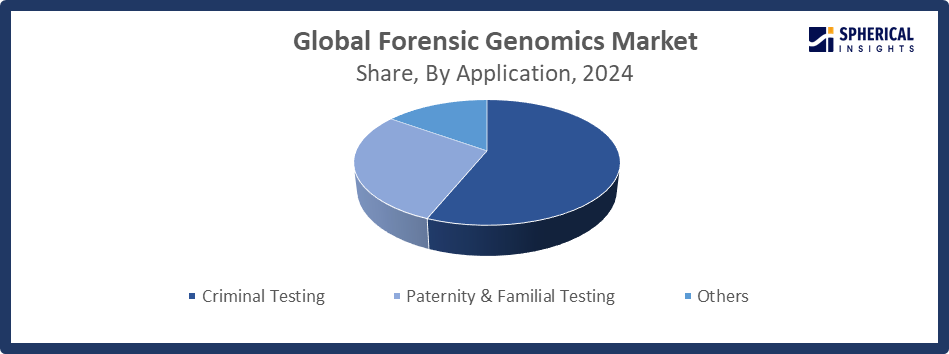Global Forensic Genomics Market Size, Share, and COVID-19 Impact Analysis, By Product (Analyzers & Sequencers, Software, and Kits & Consumables), By Application (Criminal Testing, Paternity & Familial Testing, and Others), By Region (North America, Europe, Asia-Pacific, Latin America, Middle East, and Africa), Analysis and Forecast 2025 - 2035
Industry: HealthcareGlobal Forensic Genomics Market Insights Forecasts to 2035
- The Global Forensic Genomics Market Size Was Estimated at USD 570.4 Million in 2024
- The Market Size is Expected to Grow at a CAGR of around 14.65% from 2025 to 2035
- The Worldwide Forensic Genomics Market Size is Expected to Reach USD 2565.6 Million by 2035
- Asia Pacific is expected to grow the fastest during the forecast period.

Get more details on this report -
According to a research report published by Spherical Insights and Consulting, The Global Forensic Genomics Market Size was worth around USD 570.4 Million in 2024 and is predicted to grow to around USD 2565.6 Million by 2035 with a compound annual growth rate (CAGR) of 14.65% from 2025 to 2035. The market for forensic genomics offers opportunities for improving investigative genetic genealogy, growing national DNA databases, and improving DNA analysis. Government programs such as CODIS are driving the forensic genomics market.
Global Forensic Genomics Market Forecast and Revenue Outlook
- 2024 Market Size: USD 570.4 Million
- 2035 Projected Market Size: USD 2565.6 Million
- CAGR (2025-2035): 14.65%
- North America: Largest market in 2024
- Asia Pacific: Fastest growing market
Market Overview
The ecosystem of products, services, and technologies using genomic analysis such as capillary electrophoresis, next-generation sequencing (NGS), and polymerase chain reaction (PCR) amplification for DNA profiling in legal and investigative settings is referred to as the forensic genomics market. Government initiatives, such as DOJ policies and CODIS, encourage adoption by promoting creativity, interoperability, and moral uses for public safety and justice. For Instance, In October 2024, Promega Corporation has launched a new enzyme designed to significantly reduce stutter in forensic DNA analysis. This breakthrough is expected to enhance the accuracy of DNA profiling and strengthen the company’s growth opportunities in the forensic genomics market. A growing number of crimes, such as homicides, kidnappings, and sexual assaults, as well as rapid technology advancement and increased government and corporate financing for the development of inexpensive forensic testing techniques, are driving the forensic genomics market. The increase in killings, sexual assaults, and kidnappings is one of the main factors driving the forensic genomics market. Additionally, key factors propelling forensic genomics market expansion include quick technical developments and more government and commercial investment in creating affordable forensic testing methods.
Key Market Insights
- North America is expected to account for the largest share in the forensic genomics market during the forecast period.
- In terms of product, the kits & consumables segment is projected to lead the forensic genomics market throughout the forecast period
- In terms of application, the criminal testing segment captured the largest portion of the market
Forensic Genomics Market Trends
- Technological Advancements: Single nucleotide polymorphism (SNP) analysis and next-generation sequencing (NGS) increase speed and accuracy, making it possible to process damaged or trace DNA material.
- Growing DNA Databases: Global database expansion for criminal and missing person identification is driven by government initiatives such as India's 32 forensic labs and the United States' CODIS, which has over 16 million profiles.
- Focus on Ethics and Regulation: To guarantee the ethical use of genetic data in forensic applications, governments place a strong focus on privacy protections and defined procedures.
- Growing ethical and legal frameworks, data privacy, and long-term storage problems, particularly with regard to DNA databases.
Report Coverage
This research report categorizes the forensic genomics market based on various segments and regions, forecasts revenue growth, and analyzes trends in each submarket. The report analyzes the key growth drivers, opportunities, and challenges influencing the forensic genomics market. Recent market developments and competitive strategies, such as expansion, type launch, development, partnership, merger, and acquisition, have been included to draw the competitive landscape in the market. The report strategically identifies and profiles the key market players and analyzes their core competencies in each sub-segment of the forensic genomics market.
Global Forensic Genomics Market Report Coverage
| Report Coverage | Details |
|---|---|
| Base Year: | 2024 |
| Market Size in 2024: | USD 570.4 Million |
| Forecast Period: | 2025-2035 |
| Forecast Period CAGR 2025-2035 : | 14.65% |
| 2035 Value Projection: | USD 2565.6 Million |
| Historical Data for: | 2020-2023 |
| No. of Pages: | 240 |
| Tables, Charts & Figures: | 121 |
| Segments covered: | By Product, By Application, By Region |
| Companies covered:: | Verogen, LGC Limited, QIAGEN, Illumina, Inc., Merck KGaA, Tri Tech Forensics, MGI Tech Co., Ltd., Bio-Rad Laboratories, Agilent Technologies, Promega Corporation, NicheVision Forensics, LLC, InnoGenomics Technologies, Thermo Fisher Scientific, Inc., Others |
| Pitfalls & Challenges: | COVID-19 Empact, Challenges, Future, Growth, & Analysis |
Get more details on this report -
Driving factors
The need for sophisticated DNA profiling in criminal investigations, international security, and human identification is driving the growth of the forensic genomics market. The need for sophisticated forensic genomics solutions is being driven by rising international crime rates and terrorist concerns, and adoption is also being driven by government programs to create national DNA databases. Advanced forensic genomics solutions are in high demand due to the rise in organized crime, violent crimes, and dangers associated to terrorism. Additionally, increasing technology advancements in cost effectiveness, automation, and sequencing precision are driving market expansion. Increased criminal activity, improvements in DNA analysis, growing use of forensic technologies, and encouraging government initiatives are the main factors driving the forensic genomics market.
Restraining Factor
The high price of sophisticated genomic technologies, privacy and ethical issues surrounding the use of DNA data, a lack of uniform across countries, and difficulties interpreting complex genomic data in legal and investigative contexts are some of the problems that are restricting the growth of the forensic genomics market.
Market Segmentation
The global forensic genomics market is divided into product and application.
Global Forensic Genomics Market, By Product:
- The kits & consumables segment dominated the market in 2024 and is projected to grow at a substantial CAGR during the forecast period.
Based on product, the global forensic genomics market is segmented into analyzers & sequencers, software, and kits & consumables. Among these, the kits & consumables segment dominated the market in 2024 and is projected to grow at a substantial CAGR during the forecast period. The growing number of criminal investigations, governmental initiatives to clear backlogs in crime cases, expanding knowledge of DNA profiling in criminology, and investments in forensic sciences by both public and commercial entities are some of the factors propelling the kits & consumables segment growth.
The software segment in the forensic genomics market is expected to grow at the fastest CAGR over the forecast period. Investment in software solutions that increase the effectiveness and precision of DNA profiling and other forensic techniques is being driven by the demand for precise and trustworthy forensic analysis.
Global Forensic Genomics Market, By Application:
- The criminal testing segment accounted for the largest share in 2024 and is anticipated to grow at a significant CAGR during the forecast period.
Based on application, the global forensic genomics market is segmented into criminal testing, paternity & familial testing, and others. Among these, the criminal testing segment accounted for the largest share in 2024 and is anticipated to grow at a significant CAGR during the forecast period. The increasing number of crimes committed globally is driving the criminal testing application industry. Crime resolution is greatly aided by sophisticated methods such as DNA profiling, which allow people to be identified based on their distinct genetic composition.

Get more details on this report -
The paternity & familial testing segment in the forensic genomics market is expected to grow at the fastest CAGR over the forecast period. Growing acceptance of DNA testing for family verification and an increase in paternity and inheritance disputes have fuelled demand for paternity and familial testing.
Regional Segment Analysis of the Global Forensic Genomics Market
- North America (U.S., Canada, Mexico)
- Europe (Germany, France, U.K., Italy, Spain, Rest of Europe)
- Asia-Pacific (China, Japan, India, Rest of APAC)
- South America (Brazil and the Rest of South America)
- The Middle East and Africa (UAE, South Africa, Rest of MEA)
North America Forensic Genomics Market Trends
North America is expected to hold the largest share of the global forensic genomics market over the forecast period.
The need for sophisticated forensic technologies has increased as a result of rising crime rates and a growing emphasis on resolving complicated criminal cases. Laboratory capabilities are also improved by significant government support for forensic research and development. The region's market is expanding as a result of the incorporation of DNA analysis into legal systems and rising public awareness of the significance of genetic testing. The region's market position is further reinforced by the existence of reputable forensic labs, strict legal frameworks, and extensive national DNA databases.
U.S Forensic Genomics Market Trends
Significant government funding for law enforcement and forensic science improves lab capacity and research projects. The significance of precise forensic analysis is highlighted by the growing use of DNA evidence in court cases. The federal commitment to expanding DNA databases for criminal identification is exemplified by the U.S. Department of Justice's Combined DNA Index System (CODIS), which has over 16 million profiles.
Canada Forensic Genomics Market Trends
In Canada, the development of forensic technologies and the fortification of public safety infrastructure are propelled by growing government assistance. Investments in DNA profiling, next-generation sequencing (NGS), and bioinformatics have been given top priority by federal and provincial authorities in an effort to improve criminal investigations, human identification, and legal procedures.
Asia Pacific Forensic Genomics Market Trends

Get more details on this report -
Asia Pacific is expected to grow at the fastest CAGR in the forensic genomics market during the forecast period.
The Asia-Pacific forensic genomics market is expanding quickly as a result of increased crime rates and urbanization, which fuel demand for cutting-edge forensic technology. Governments in nations like China, India, Japan, and South Korea are actively updating forensic skills and establishing national DNA databases through financing and policy support programs. Furthermore, the region's market is developing more quickly due to the growth of research institutes, expanding partnerships with worldwide forensic organizations, and developments in next-generation sequencing (NGS).
China Forensic Genomics Market Trends
Strong government initiatives, higher investments in forensic infrastructure, and the creation of a national DNA database are the main factors propelling the China forensic genomics market. The industry is expanding as a result of growing public interest in genetic testing for ancestry and familial purposes. The country's market is growing thanks to technological developments, the growing need for precise criminal identification, and the incorporation of genetic technologies into judicial systems.
Japan Forensic Genomics Market Trends
The development of cutting-edge forensic technologies, like as DNA analysis, is aggressively encouraged by the Japanese government in an effort to increase public safety. Government-led developments in forensic science, investments in next-generation sequencing technologies, and the modernization of law enforcement capacities are all contributing to the continuous growth of the Japanese forensic genomics market.
Competitive Analysis:
The report offers the appropriate analysis of the key organizations/companies involved within the global forensic genomics market, along with a comparative evaluation primarily based on their type of offering, business overviews, geographic presence, enterprise strategies, segment market share, and SWOT analysis. The report also provides an elaborate analysis focusing on the current news and developments of the companies, which includes type development, innovations, joint ventures, partnerships, mergers & acquisitions, strategic alliances, and others. This allows for the evaluation of the overall competition within the market.
Worldwide Top Key Players In The Forensic Genomics Market Include
- Verogen
- LGC Limited
- QIAGEN
- Illumina, Inc.
- Merck KGaA
- Tri Tech Forensics
- MGI Tech Co., Ltd.
- Bio-Rad Laboratories
- Agilent Technologies
- Promega Corporation
- NicheVision Forensics, LLC
- InnoGenomics Technologies
- Thermo Fisher Scientific, Inc.
- Others
Key Target Audience
- Market Players
- Investors
- End-users
- Government Authorities
- Consulting And Research Firm
- Venture capitalists
- Value-Added Resellers (VARs)
Recent development
- In May 2024, The FBI and QIAGEN announced a partnership to develop a new digital PCR test for the QIAcuity platform that would improve DNA analysis from human samples in forensic applications. Law enforcement and forensic investigators will be able to examine a greater variety of evidence more rapidly and accurately thanks to this DNA quantification. The collaboration strengthens QIAGEN's position as a leader in forensic science and human identification.
- In February 2024, Promega has launched its new Reduced Stutter Polymerase, a modified enzyme aimed at significantly minimizing stutter artifacts in forensic DNA testing. This innovation enhances the accuracy of STR analysis, aiding clearer interpretation of complex DNA mixtures in criminal investigations.
- In February 2022, ISHI has partnered with Forensic Genomics as its official journal to advance forensic DNA science. Symposium Manager Carol Bingham stated the collaboration will offer attendees new opportunities to explore cutting-edge research and technologies critical to their forensic work.
Market Segment
This study forecasts revenue at the global, regional, and country levels from 2020 to 2035. Spherical Insights has segmented the forensic genomics market based on the following segments:
Global Forensic Genomics Market, By Product
- Analyzers & Sequencers
- Software
- Kits & Consumables
Global Forensic Genomics Market, By Application
- Criminal Testing
- Paternity & Familial Testing
- Others
Global Forensic Genomics Market, By Regional Analysis
- North America
- US
- Canada
- Mexico
- Europe
- Germany
- UK
- France
- Italy
- Spain
- Russia
- Rest of Europe
- Asia Pacific
- China
- Japan
- India
- South Korea
- Australia
- Rest of Asia Pacific
- South America
- Brazil
- Argentina
- Rest of South America
- Middle East & Africa
- UAE
- Saudi Arabia
- Qatar
- South Africa
- Rest of the Middle East & Africa
Frequently Asked Questions (FAQ)
-
1. What is the CAGR of the forensic genomics market over the forecast period?The global forensic genomics market is projected to expand at a CAGR of 14.65% during the forecast period.
-
2. What is the market size of the forensic genomics market?The global forensic genomics market size is expected to grow from USD 570.4 million in 2024 to USD 2565.6 million by 2035, at a CAGR 14.65% of during the forecast period 2025-2035.
-
3. Which region holds the largest share of the forensic genomics market?North America is anticipated to hold the largest share of the forensic genomics market over the predicted timeframe.
-
4. Who are the top companies operating in the global forensic genomics market?Verogen, LGC Limited, QIAGEN, Illumina, Inc., Merck KGaA, Tri Tech Forensics, MGI Tech Co., Ltd., Bio-Rad Laboratories, Agilent Technologies, Promega Corporation, NicheVision Forensics, LLC, InnoGenomics Technologies, Thermo Fisher Scientific, Inc., and others.
-
5. What factors are driving the growth of the Forensic Genomics market?The growth of the Forensic Genomics market is driven by technological advancements, increasing crime rates, government initiatives, expanding DNA databases, and rising demand for accurate, high-throughput solutions in forensic investigations.
-
6. What are market trends in the Forensic Genomics market?The use of next-generation sequencing (NGS), the combination of bioinformatics and artificial intelligence (AI), portable forensic technologies, their growing application in civil cases, and the global growth of forensic databases and infrastructure are prominent themes.
-
7. What are the main challenges restricting wider adoption of the Forensic Genomics market?The high expense of cutting-edge technologies, privacy and ethical issues, a lack of standardization, a lack of technical know-how, and the difficulties of interpreting tainted or damaged DNA evidence in legal and investigative settings are some of the primary challenges.
Need help to buy this report?